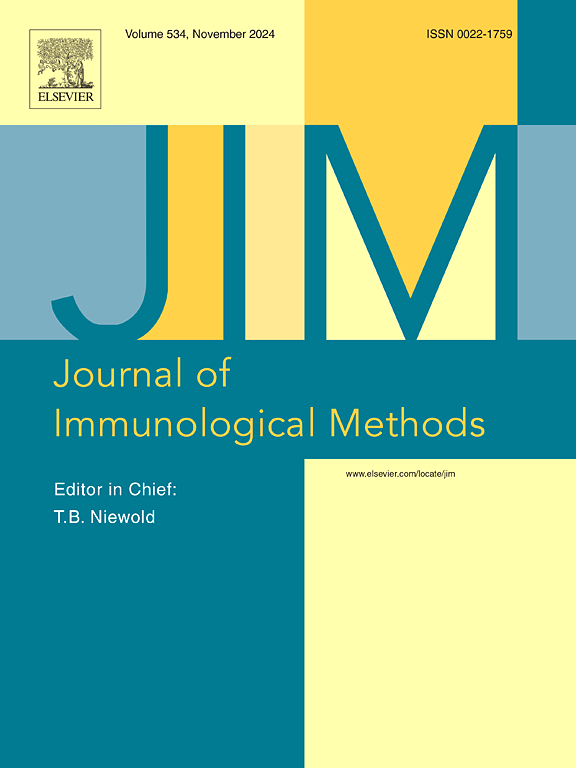从放血到外周血单个核细胞分离;在艾滋病毒高流行环境中,时间和生命早期暴露于艾滋病毒/抗逆转录病毒药物对儿科样本细胞产量和活力的影响。
IF 1.6
4区 医学
Q4 BIOCHEMICAL RESEARCH METHODS
引用次数: 0
摘要
背景:病毒感染/暴露和从采血到外周血单个核细胞(PBMC)分离(TPP)的时间可能影响PBMC的产量和活力。我们研究了TPP和早期HIV/ART暴露对PBMC的影响,包括NK细胞的产量和活力。方法:使用不同TPP的EDTA管中的血液,通过密度梯度离心分离PBMCs,在显微镜下计数,并用台盼蓝法评估活力。抗体染色(CD14, CD3和CD19)排除单核细胞和T/B淋巴细胞,而CD16和CD56染色用活/死标记鉴定活NK细胞。比较hiv暴露的未感染(HEU)儿童(长期[HEULT]和中期[HEUMT] ART暴露)、hiv暴露的感染(HEI)和hiv未暴露的未感染(HUU)儿童。结果:我们纳入了112名儿童(50% %为女性),中位年龄为5.1 岁[四分位数间距(IQR):4.8-6.0],分为37-HUU、36-HEULT、34-HEUMT和5-HEI儿童。中位血容量为7.5 ml (IQR:7.5-8.0), HEI患儿的PBMC产率略高于HUU和HEU患儿(p = 0.092)。TPP中位数为90 分钟(IQR: 64.8 - -112.0),剩下可行性高(> 95 %)3 h,这之后的收益率/毫升下降相比,TPP ≤ 1 h (1.3 vs 2.8 × 106细胞/毫升)(p = 0.010)为所有的孩子。总体而言,TPP与产率/ml和活力呈负相关(r = -0.35,p )。结论:HIV感染可能增加PBMC产率,而非暴露。3 h以下的TPP是最佳产量的理想选择。本文章由计算机程序翻译,如有差异,请以英文原文为准。
From phlebotomy to peripheral blood mononuclear cell isolation; effect of time and early-life HIV/ART exposure on cell yield and viability in paediatric samples in a high HIV prevalence setting
Background
Viral infection/exposure and time from phlebotomy to peripheral blood mononuclear cell (PBMC) isolation (TPP) may affect PBMC yield and viability. We investigated the impact of TPP and early-life HIV/ART exposure on PBMC, including NK cells yield and viability.
Methods
Blood in EDTA tubes with varying TPP was used to isolate PBMCs via density-gradient centrifugation, counted under a microscope, and assessed for viability with Trypan-Blue. Antibody staining (CD14, CD3, and CD19) excluded monocytes and T/B lymphocytes, while CD16 and CD56 staining with a LIVE/DEAD marker identified viable NK cells. Comparisons were made among HIV-exposed uninfected (HEU) children (long-term [HEULT] and medium-term [HEUMT] ART exposure), HIV-exposed infected (HEI), and HIV-unexposed uninfected (HUU) children.
Results
We enrolled 112 children (50 % female) with a median age of 5.1 years [interquartile range (IQR):4.8–6.0], categorized as 37-HUU, 36-HEULT, 34-HEUMT, and 5-HEI children. Median blood volume was 7.5 ml (IQR:7.5–8.0), with HEI children showing slightly higher PBMC yields/ml than HUU and HEU (p = 0.092). Median TPP was 90 min (IQR:64.8–112.0), with viability remaining high (>95 %) up to 3 h, after this the yields/ml decreased compared to TPP ≤ 1 h (1.3 vs. 2.8 × 106 cells/ml) (p = 0.010) for all children. Overall, TPP negatively correlated with yields/ml and viability (r = −0.35, p < 0.001; r = −0.47, p < 0.001 respectively). Median frequency of viable CD56 + CD16+/− NK cells was 8.2 %, unaffected by neither TPP nor HIV/ART exposure. Total lymphocytes were lower in males [18.6 % (IQR:11.3–22.2)] than in females [23.8 % (IQR:14.3–29.9)] (p = 0.018).
Conclusion
HIV infection, not exposure, may increase PBMC yields. TPP under 3 h is ideal for optimal yields.
求助全文
通过发布文献求助,成功后即可免费获取论文全文。
去求助
来源期刊
CiteScore
4.10
自引率
0.00%
发文量
120
审稿时长
3 months
期刊介绍:
The Journal of Immunological Methods is devoted to covering techniques for: (1) Quantitating and detecting antibodies and/or antigens. (2) Purifying immunoglobulins, lymphokines and other molecules of the immune system. (3) Isolating antigens and other substances important in immunological processes. (4) Labelling antigens and antibodies. (5) Localizing antigens and/or antibodies in tissues and cells. (6) Detecting, and fractionating immunocompetent cells. (7) Assaying for cellular immunity. (8) Documenting cell-cell interactions. (9) Initiating immunity and unresponsiveness. (10) Transplanting tissues. (11) Studying items closely related to immunity such as complement, reticuloendothelial system and others. (12) Molecular techniques for studying immune cells and their receptors. (13) Imaging of the immune system. (14) Methods for production or their fragments in eukaryotic and prokaryotic cells.
In addition the journal will publish articles on novel methods for analysing the organization, structure and expression of genes for immunologically important molecules such as immunoglobulins, T cell receptors and accessory molecules involved in antigen recognition, processing and presentation. Submitted full length manuscripts should describe new methods of broad applicability to immunology and not simply the application of an established method to a particular substance - although papers describing such applications may be considered for publication as a short Technical Note. Review articles will also be published by the Journal of Immunological Methods. In general these manuscripts are by solicitation however anyone interested in submitting a review can contact the Reviews Editor and provide an outline of the proposed review.

 求助内容:
求助内容: 应助结果提醒方式:
应助结果提醒方式:


